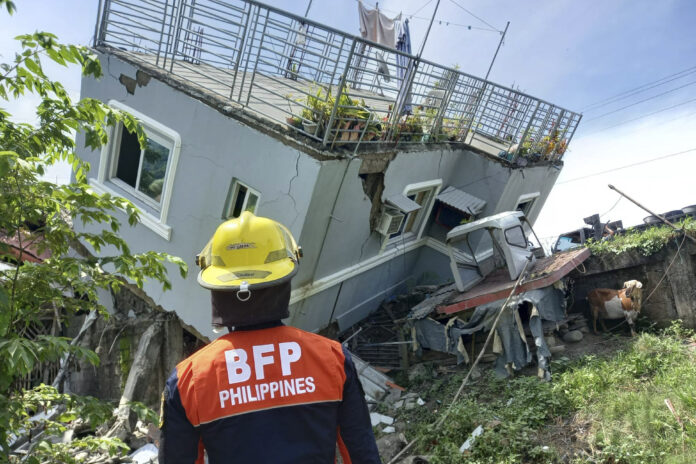A strong earthquake set off landslides and damaged buildings in the northern Philippines on Wednesday, killing at least five people and injuring dozens. In the capital, hospital patients were evacuated and terrified people rushed outdoors.
The seven-magnitude quake was centered in a mountainous area of Abra province, said Renato Solidum, the head of the Philippine Institute of Volcanology and Seismology, who described the midmorning shaking as a major earthquake.
“The ground shook like I was on a swing and the lights suddenly went out. We rushed out of the office, and I heard screams and some of my companions were in tears,” said Michael Brillantes, a safety officer of the Abra town of Lagangilang, near the epicentre.
“It was the most powerful quake I’ve felt and I thought the ground would open up,” Brillantes told The Associated Press by cellphone.
In this handout photo provided by the Bureau of Fire Protection, rescuers try to pull out a trapped resident from under a collapsed structure after a strong earthquake struck La Trinidad, Benguet province, northern Philippines on July 27.
Bureau of Fire Protection via AP
At least five people died — mostly in collapsed structures. One villager died when hit by falling cement slabs in his house in Abra, where dozens of others were injured. In Benguet province, a worker was pinned to death after a small building that was under construction collapsed in the strawberry-growing mountain town of La Trinidad.
Hundreds of houses and buildings had cracked walls, including some that collapsed in Abra, where President Ferdinand Marcos Jr., who took office less than a month ago, planned to travel Thursday to meet victims and local officials.
Marcos Jr. told a news conference he was in his office at the riverside Malacanang presidential palace complex when the chandeliers began swaying and making clanking sounds. “It was very strong,” he said of the ground shaking.
Trending Stories
Singer says impromptu song at Maskwacis papal apology being mistaken for ‘O Canada’
Advocate says Jake Virtanen acquittal shows high bar for justice in sex assault cases
In this photo provided by the Bureau of Fire Protection, rescuers walk beside a collapsed wall after a strong earthquake struck Vigan, Ilocos Sur province, Philippines on July 27.
Bureau of Fire Protection via AP
In a chilling near-death experience, Filipino photojournalist Harley Palangchao and companions were traveling downhill in two vans in Mountain Province when they suddenly heard thunder-like thuds and saw an avalanche of boulders as big as cars raining down just ahead of them from a towering mountain.
Amid screams of his companions in their van to “back up, back up!” the 44-year-old father of three raised his camera in the front seat and snapped what he feared could be the final pictures of his life. The van in front of them was grazed by a boulder, injuring one, but he and others in the second van drove backward fast enough and escaped unscathed.
“I was thinking there should be at least a record if something happened to us,” Palangchao told the AP. “It was a horrific experience.”
In this photo provided by the Bureau of Fire Protection, a vehicle is damaged after a wall collapsed following a strong earthquake that struck Vigan, Ilocos Sur province, Philippines on July 27.
Bureau of Fire Protection via AP
The Red Cross issued a picture of a three-story building precariously leaning toward a debris-covered road in Abra. A video taken by a panicking witness showed parts of an old stone church tower peeling off and falling in a cloud of dust on a hilltop.
Patients, some in wheelchairs, and medical personnel were evacuated from at least two hospitals in Manila, about 300 kilometres south of Lagangilang, but were later told to return after engineers found only a few minor cracks on walls.
The quake’s strength was lowered from the initial 7.3 magnitude after further analysis. The quake was set off by movement in a local fault at a depth of 17 kilometres, the institute said, adding it expected damage and more aftershocks.
The Philippines lies along the Pacific “Ring of Fire,” an arc of faults around the Pacific Ocean where most of the world’s earthquakes occur. It is also lashed by about 20 typhoons and tropical storms each year, making it one of the world’s most disaster-prone countries.
A magnitude 7.7 quake killed nearly 2,000 people in the northern Philippines in 1990.
© 2022 The Canadian Press



